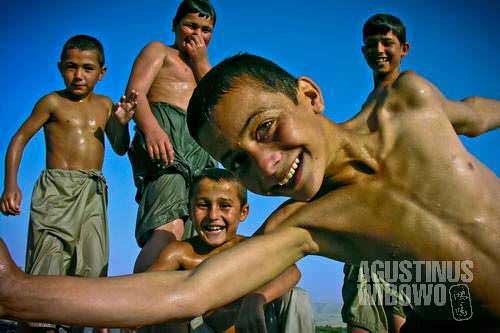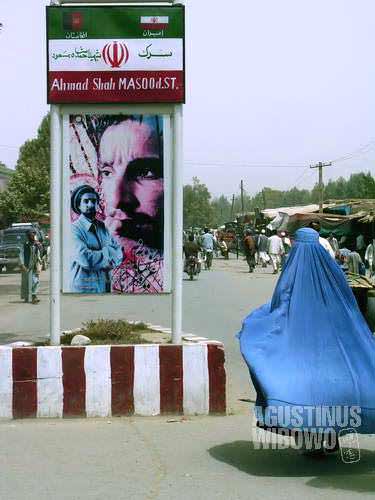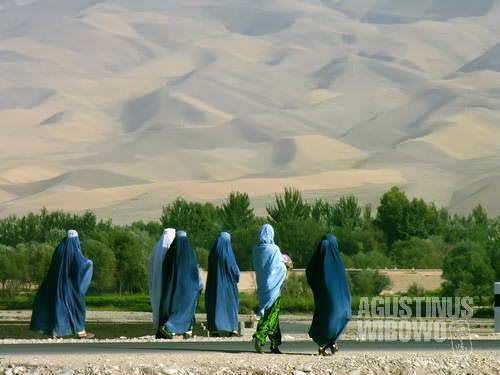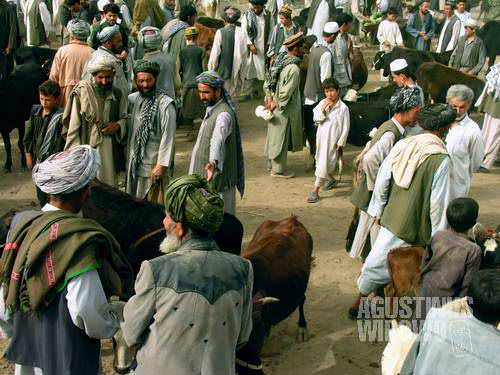Taloqan – The Colorful Mondays
“First it was the culture, then it mixed with the religion” – Sa’dat
The city of Taloqan is the capital of the Takhar province, one of Afghanistan northern provinces. Takhar was part of the Qataghan province which once comprised the nowadays provinces of Kunduz, Takhar and Baghlan. Taloqan is hot in summer although compared to Kunduz, it’s much cooler. The city is dusty, but the smoothly paved road which connected the sleepy provincial capital to Kabul promised its brighter future.
The city has somehow a strong link with the Islamic Republic of Iran. Unlike other cities in Afghanistan, the roads in Taloqan has clear name and road signs, and many of the main road signs in the town center are backgrounded with Iranian flag, and signed “Afghanistan and Iran”. Some of the roads have quite Iranian smell, like the “Ayatollah Khomeini” St. Some other main roads are Hafez St., and as in all other cities in Afghanistan, the “Ahmad Shah Massoud” St. Massoud is a Tajik warrior from the Panjshir valley who fought against the Taliban and now is respected by many as a national hero.
The people of Taloqan are Uzbek predominantly, but there are some Pashtuns from Kunduz and the Tajiks. The Taliban influence here is minimum, but Taloqan is the first Afghan city I saw with almost 100 percent of the women wear the full covering burqa. It was even much more intense compared to the Kandahar, once the base of Taliban power. Burqa was not introduced here by the Taliban. In Kabul, before the time of Taliban, burqa was not common, and after Taliban rule it became the fashion of the city. Under the communist regimes, burqa was outlawed and Kabul was always the first city in Afghanistan in the term of ‘modernization’. But this is not the case of Taloqan.
Burqa was part of the culture of the people in Taloqan since long ago. Sa’dat, a journalist working for Radio Takharistan claimed that burqa came since Islam came. But burqa was not Islamic. In the Holy Quran it was not stated that a woman should cover her whole face. “It was first the culture, then it was mixed by the religion,” explained Sa’dat.
Modernization, thus in many occasions being interpreted as “unveiling”, never really comes to Taloqan. King Amanullah, rose to power in 1919, intensified modernization. One of the programs was to separate the women from bruqas. His wife went to bazaar unveiled, and it was a successful propaganda for the people in Kabul. The unveiling program reached big cities like Kabul, Herat, Kandahar, and even Kunduz, 60 km away from Taloqan. Amanullah modernization program received huge resistance from the traditional religiously conservative people in the country sides. Burqa was the only fashion in Taloqan, and even under communist regimes where unveiled, short-sleeved working women were the scene of Kabul streets, Taloqani women still chose to hide under the anonymous burqa fashion.
Abdul Mateen Saferaz, a young ambitious journalist from Kunduz, is working in Takhar province. He works for Radio Takharistan, Pajhwok News Agency, and a monthly woman magazine “Sarv” for the same time. He also studies law in the local university. He is too busy for his young age of 24. He earns 10$ to 30$ for every article he sends to Pajhwok. As a correspondent, he earns much more than even senior journalists in Indonesia. He loved journalism, and it was not merely for money. He just got the prize to go to Slovakia, as the republic offered seats for young Afghans for comparison study research.
As an editor of a woman magazine, Sarferaz expressed his difficulty to work in such society. Some of the members of the team are girls, and they are important members as this is a magazine for the women. But the society and culture don’t allow people from opposite sexes to work together in the same office. Radio Takharistan has different room for the woman staff, underground. The monthly magazine of Sarv, with limited publication printed material of 8 pages, doesn’t have the luxury. The society still even despised women working. Sarferaz has to arrange a garcon to pick the articles from the female writers, but most of the time he does it himself. Getting permission to the girl school for interview is also extremely difficult and bureaucratic.
Dr Syed Amin, a Taloqani who once worked as Badakhsan health director and now has duty in Kunduz, said it was still impossible for the male doctors to cure female patients. There is actually lack of female doctors in the province, and this is a problem to be solved. It is not the law which forbid. It is the culture.
The culture rooted here was long before the Taliban introduced their conservative perception of Islam. The people of the area disliked Taliban. In fact there was a huge resistance against Taliban power in all northern provinces, predominated by the minority non-Pashtuns. Taloqan was captured by the Taliban after 2 weeks of battle, but Taliban never went further from Takhar province. Badakshan, the far northeast province didn’t really interest them.
The news about fundamentalism always attract the interest of the people. On Saturday, 22 July 2006, there was suicide bomb in Kandahar, killed 10 and wounded 40 others, with victims included a TV Ariana camera man. The guys in Radio Takharistan watched with horror. But the people now ridiculed how collar and furniture were outlawed simply because the Prophet didn’t use these stuff. Despite of that, Taliban didn’t need to enforce the using of burqa in the northern provinces. Even today, when more and more women in Kabul chose to leave burqa, female students in Taloqan University still prefer to wear burqa for traveling from their homes to the school. “If a girl doesn’t wear burqa, people will look at her and think she is not good,” said Sarferaz.
Despite the heat that one might imagine the women in Taloqan suffer under their burqas, Taloqan is already a very hot city. The temperature rises to 42 degree. Electricity is not available in Taloqan yet. The people have to rely on private generators to generate electricity in their homes. Fans to cool down the temperature are still luxurious for the have-nots. The only one Internet Café was closed down since a month ago, and for journalists this is nightmare.
It’s still not sure when modernization will reach this provincial and how it will change the life there. Until then, time has slower velocity of flowing. The pools and river become the natural way for the men (not women) to pass the fierce summer heat. Hand made (literally made by hands) ice cream is life savior. Hammam (public bathroom) is also the place for the men to shower; it cost 25 Af for a hot shower session, a luxury. Most houses don’t have bathroom with flowing water. The old city next to the river, once described by Marco Polo as the outstanding castle of Taikhan, now become more and more nondescript. The river is still a cool place for swimming, washing the horses, feeding the cattle, and also cleaning the cars.
The past history of Taloqan is intensified on Mondays and Thursdays. The bazaar days. The tradition dated back hundreds years ago from their Central Asian ancestors. On these days, people from the villages in far districts of the province flourished the town for trading. The most colorful might be the animal market, where villagers came for hopeful trades. Men with different types and colors of caps and turbans came with their goats, sheep, horses, cows, donkeys, etc. Old, white bearded men (Uzbek: aksakal) with their Uzbek coat and flat cap intensified the atmosphere of Central Asian past. And when the aksakal sit on the little poor donkey, he resembled Mulla Nasruddin (the fool and wise man in Central Asian folklores).
The trade is a matter of luck. Qurban brought his 4 goats from a village of the province and wishing to sell all of them at 1800 Af each. The average price of a goat is 2000 Af, sheep 5000 Af, donkey 5000 Af. Horses and cows cost much more, up till 20,000 Af for a beautiful horse. The main indicator of a good beast is the teeth.
Not only is the trade of the cattle there in the riverside bazaar. The slaughtering of the goat and sheep take place next to the river, and the flowing red blood might be awareness for other living livestock of the fate of the compatriots, might be their future fate also. A boy of a butcher blew a dead animal like a balloon before his father evacuated the contents of the stomach of the poor beast. Garbage pickers also collected the ‘jewels’ from the rubbish hills.
The other part of the bazaar sells daily needs like wheat, rice, peanuts, and corns. The seeds pale up like hills of different colors. The horse charts wait in line as transport of the traders. The animal transport like horses and donkeys still dominate the traffic of the town.
The delicious raisin and corn seeds are still the primadona of the snack markets. The making of the fried corn seed is preceded by frying the seeds in huge pan full of sand and mixed by little amount of oil and yellow coloring powder. The yellow ash produced by the mixture makes the cook like a hepatitis patient. The yellow, fried corn seed then filtered from the sand before preserved.
The weaving blue and white seas of burqas, the green black Zebra cloaks of the Uzbek elders, the brown hairs of the donkeys, purple ripe raisins, simmering yellow of the corn seeds shines the colors of the ancient Central Asian town of Taloqan.












Leave a comment